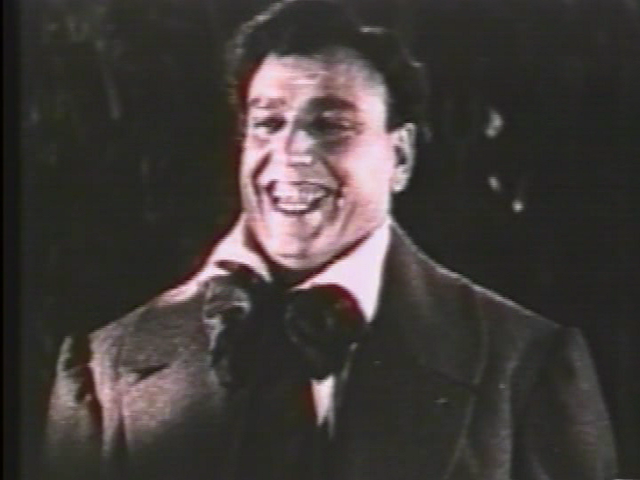
Cabiria (1914) was the seminal Italian historical epic, adding to the gigantic sets and overplayed melodrama of predecessors like Nero and The Fall of Troy, with elegant camera moves (using Segundo de Chomon's first purpose-built dolly) and celebrity cameos for Hannibal and Archimedes. "It had everything but a story," observed Karl Brown, D.W. Griffith's camera assistant. Giovanni Pastrone and Gabriele D'Annunzio's historical pageant influenced movies from Intolerance to Metropolis to Conan the Barbarian, and Fellini borrowed its heroine's name for his wife's role in The White Sheik and Nights of Cabiria.
But the figure who caught the public imagination was not the titular heroine, but Maciste, the heroic slave, played by Bartolomeo Pagano, a Genovese longshoreman with a spectacularly muscled physique. Maciste/Pagano went on to star in twenty-four more movies over the next fourteen years, of which the most famous (and the only one available, albeit in somewhat butchered form) is Guido Brignone's Maciste in Hell (1925).

Above: "Hey Pluto!"
One has to assume that Maciste and Pagano were interchangeable in the public's mind, because nothing about Maciste remains from the original movie in this later sequel. Maciste is no longer a Nubian slave in ancient Roman times (Pagano blacked up for the role). He is now a prosperous middle-class Italian citizen in what looks to be the late eighteenth century, although confusingly, when the devil offers Maciste world dominion, we see aerial shots of modern Paris and New York. Maciste is now also white. Maybe this racial reassignment is explained in the intervening films?* Maybe Maciste is reincarnated through the ages, whenever he's needed. At any rate, his newly pallid tones suggest a pandering to Mussolini, who no doubt preferred his national heroes' complections no darker than olive. Only when, after kissing a sultry demoness, Maciste is transformed into a horned denizen of the pit, does his skin assume a bronzed tone more in line with his origins, which in itself says something about racial attitudes in twenties Italy.
Time, and good eating, has wrought another transformation upon Pagano, who is now less barrel-chested than barrel-bodied, making him less inclined to strip down to a tiny tunic, so that most of his heroics are played out within straining shirt and waistcoat. But when banished to the infernal regions for obscure reasons, Maciste still kicks ass. His first punch takes a demon's head clean off, impaling it on a trident twenty feet away. The unperturbed head, bashed all out of shape, goes through some claymation transmogrifications (courtesy of Chomon, who's still around lending his special effects expertise to the Italian cinema), is chucked back to its owner, and replaced upon his shoulders by jump-cut, and the demon laughs in Maciste's face. Jamming a trident into the head demon's belly just makes him belch fire. It seems as if the legendary strongman's physical prowess will be of little avail in this realm, except as a means to motivate more and more extraordinary visual effects.

Above: A straight rip from Gustave Dore's illustrations to the Inferno.
Merging the proto-peplum genre with Dante's Inferno, which had been loosely adapted for cinema in Italy in 1911, the movie takes a pretty light-hearted view of Hell, where as an honored guest Maciste gets to fly about on a dragon and watch scenes of his earthly friends at play on television (yes, they have television in Hell: that surprises you?). Eventually Big Mac secures his release by helping Pluto win a civil war, although how a war can be winnable when both sides are apparently indestructible seems unclear.
Director Brignone seems an interesting fellow, at least for the pleasing symmetry of his career: after directing two Maciste romps in the twenties, he essayed a variety of genres, until fashion came full circle and musclebound epics were back in style: he finished his life with Sheba and the Gladiator in 1959, featuring Anita Ekberg and uncredited co-direction (it's possible Brignone actually died in the director's chair) by the great Riccardo Freda and somebody called Michelangelo Antonioni.
This stupid movie needs a restoration bad! Not only is the available video a chopped American cut, but the poor picture quality does terrible damage to the infernal scenes, which are teeming with demonic life: the satanic seductresses in their Flash Gordon brass bras, and the scurrying soldiery, rat tails dangling from their caveman furry nappies, crawl about the screen, filling foreground, midground and background with eye-catching detail. One wants to get right in there and, you know, poke around, but the fuzzy image quality intercepts the eye like a gauzy web, preventing full absorption. If a full restoration were achieved and the results made available on DVD and Blu-ray, how many of us would follow Maciste into the sulfurous yet seductive netherworld, never to emerge?

*Not quite. In the first sequel, Maciste (1915), a young girl in trouble sees Cabiria and decides to enlist the he-man in her real life adventure. Finding Maciste the movie star at the gym, she persuades him to help. That gets Mac out of the Roman arena and into the modern one, but doesn't explain the starched wigs and frock coats of Maciste in Hell.
***
The Forgotten is a regular Thursday column by David Cairns, author of Shadowplay.